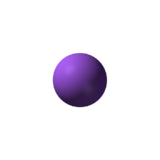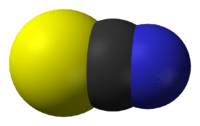Sodium thiocyanate
| | |||
| |||
| Names | |||
|---|---|---|---|
| IUPAC name
Sodium thiocyanate | |||
| Other names
Sodium rhodanide Sodium sulfocyanate Sodium rhodanate Thiocyanic acid, sodium salt | |||
| Identifiers | |||
| 540-72-7 | |||
| 3D model (Jmol) | Interactive image | ||
| ChEBI | CHEBI:30952 | ||
| ChEMBL | ChEMBL1644028 ChEMBL84336 ChEMBL1078613 | ||
| ChemSpider | 10443 | ||
| ECHA InfoCard | 100.007.960 | ||
| EC Number | 208-754-4 | ||
| PubChem | 516871 | ||
| RTECS number | XL2275000 | ||
| UNII | 5W0K9HKA05 | ||
| |||
| |||
| Properties | |||
| NaSCN | |||
| Molar mass | 81.072 g/mol | ||
| Appearance | deliquescent colorless crystals | ||
| Density | 1.735 g/cm3 | ||
| Melting point | 287 °C (549 °F; 560 K) | ||
| Boiling point | 307 °C (585 °F; 580 K) decomposes | ||
| 139 g/100 mL (21 °C) 225 g/100 mL (100 °C) | |||
| Solubility | soluble in acetone, alcohols, ammonia, SO2 | ||
| Acidity (pKa) | -1.28 | ||
| Refractive index (nD) |
1.545 | ||
| Structure | |||
| orthorhombic | |||
| Hazards | |||
| Safety data sheet | ICSC 0675 | ||
| EU classification (DSD) |
Harmful (Xn) | ||
| R-phrases | R20/21/22, R32, R36, R37, R38 | ||
| S-phrases | S22, S26, S36 | ||
| NFPA 704 | |||
| Lethal dose or concentration (LD, LC): | |||
| LD50 (median dose) |
764 mg/kg (oral, rat)[1] | ||
| Related compounds | |||
| Other anions |
Sodium cyanate Sodium cyanide | ||
| Other cations |
Potassium thiocyanate Ammonium thiocyanate | ||
| Except where otherwise noted, data are given for materials in their standard state (at 25 °C [77 °F], 100 kPa). | |||
| | |||
| Infobox references | |||
Sodium thiocyanate(sometimes called Sodium sulphocyanide) is the chemical compound with the formula NaSCN. This colorless deliquescent salt is one of the main sources of the thiocyanate anion. As such, it is used as a precursor for the synthesis of pharmaceuticals and other specialty chemicals.[2] Thiocyanate salts are typically prepared by the reaction of cyanide with elemental sulfur:
- 8 NaCN + S8 → 8 NaSCN
Sodium thiocyanate crystallizes in an orthorhombic cell. Each Na+ center is surrounded by three sulfur and three nitrogen ligands provided by the triatomic thiocyanate anion.[3] It is commonly used in the laboratory as a test for the presence of Fe3+ ions.
Applications in chemical synthesis
Sodium thiocyanate is employed to convert alkyl halides into the corresponding alkylthiocyanates. Closely related reagents include ammonium thiocyanate and potassium thiocyanate, which has twice the solubility in water. Silver thiocyanate may be used as well; the precipitation of insoluble silver halides help simplify workup. Treatment of isopropyl bromide with sodium thiocyanate in a hot ethanolic solution affords isopropyl thiocyanate.[4] Protonation of sodium thiocyanate affords isothiocyanic acid, S=C=NH (pKa = -1.28).[5] This species is generated in situ from sodium thiocyanate; it adds to organic amines to afford derivatives of thiourea.[6]
References
- ↑ Sodium thiocyanate, chemicalland21.com
- ↑ Schwan, A. L. (2001). Encyclopedia of Reagents for Organic Synthesis. New York: John Wiley & Sons. doi:10.1002/047084289X.rs109.
- ↑ van Rooyen, P. H.; Boeyens, J. C. A. (1975). "Sodium thiocyanate". Acta Crystallographica. B31 (12): 2933–2934. doi:10.1107/S0567740875009326.
- ↑ Shriner, R. L. (1943). "Isopropyl Thiocyanate". Org. Synth.; Coll. Vol., 2, p. 366
- ↑ Chiang, Y.; Kresge, A. J. (2000). "Determination of the Acidity Constant of Isothiocyanic Acid in Aqueous Solution". Canadian Journal of Chemistry. 78 (12): 1627–1628. doi:10.1139/cjc-78-12-1627.
- ↑ Allen, C. F. H.; VanAllan, J. (1955). "2-Amino-6-Methylbenzothiazole". Org. Synth.; Coll. Vol., 3, p. 76


